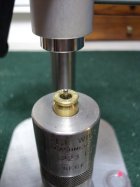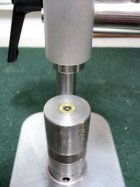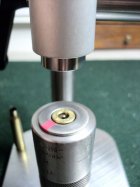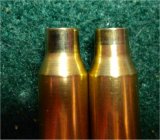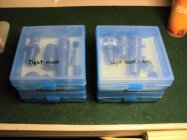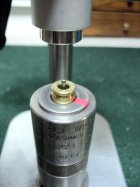You are using an out of date browser. It may not display this or other websites correctly.
You should upgrade or use an alternative browser.
You should upgrade or use an alternative browser.
Neco tool questions.
- Thread starter commando57
- Start date
It is my friend's gauge. He uses it to evaluate various brands of cases for his varmint rifles. I mostly shoot my 6PPC, and take the .220 Russian cases on faith, having not heard of any runout issues. Another factor is my FL die. It is a Harrell Vari-Base die (no longer available), that does not size the diameter of the front half of the case body, and has an interchangeable insert in it that only sizes the back about .0005. Of course it bumps the shoulder, as well as sizing the neck with a bushing. With so little sizing, and the quality of the brass, things work pretty well. I will say that for my varmint rifles, and other, where non Lapua brass is used, I look at the bulge above the head, to see how even it is around the case, and use a concentricity gauge to check sized cases. I have also done this with my PPC brass, and can report that carbide bushings produce straighter cases...when used in my die.
Wayne, I do not FL size brass -beyong fireforming(which is FL upsizing).
My sizing is functionally the same as boyd's, only I don't currently need base sizing.
I use Redding body dies worked by JLC Precision for bumping, and Wilson bushing dies for partial neck sizing.
The qualifiers for this approach are well designed cartriges, kept within SAAMI max pressures.
If I accepted higher pressures, I would have JLC provide me needed sizing at the base. The custom die makers out there can do about anything you want, and at a reasonable cost.
IMO, once you've run a case through an off the shelf FL die, you ruined it.
It doesn't matter to me how well it might shoot. It would never again pass my tests, and so every bad shot at the range would then bring this factor to front.
For me every preparation eliminates a factor from question, and this allows me to determine actual problems quicker.
Sometimes, very tough problems..
My sizing is functionally the same as boyd's, only I don't currently need base sizing.
I use Redding body dies worked by JLC Precision for bumping, and Wilson bushing dies for partial neck sizing.
The qualifiers for this approach are well designed cartriges, kept within SAAMI max pressures.
If I accepted higher pressures, I would have JLC provide me needed sizing at the base. The custom die makers out there can do about anything you want, and at a reasonable cost.
IMO, once you've run a case through an off the shelf FL die, you ruined it.
It doesn't matter to me how well it might shoot. It would never again pass my tests, and so every bad shot at the range would then bring this factor to front.
For me every preparation eliminates a factor from question, and this allows me to determine actual problems quicker.
Sometimes, very tough problems..
bozo699
Gold $$ Contributor
Mike, Thanks for the reply, I am getting ready to prep some 6.5*284 Lapua brass, when done it will be 6*284, I don't have any custom dies, I have always f/l sized and bumped the shoulder's .001 so everything is consistent, do you think I could make decent ammo with my Redding bushing neck die? I am running fairly high pressures and would think I need to bump the shoulder's, I do have a Redding body die.
Wayne.
Wayne.
I use Redding body dies worked by JLC Precision for bumping, and Wilson bushing dies for partial neck sizing.
The qualifiers for this approach are well designed cartridges, kept within SAAMI max pressures
So you get your body dies dies honed so they don't size the base (or size it minimally) and provide a minimum amount of sizing further up the case?
I am interested in the comment about the need for well designed cartridges with this approach. Does this work better with short fatter cases (WSM, Saum etc) as opposed to longer thin cases. What are your thoughts here?
Wayne
Yeah, this side of 40deg+ shoulders your gonna reach a point where bumping is required -everytime.
It'll take 3-4firings before you get there, but you will.
If you want to bump only/partial NS, you need only to find the max pressure that allows it(YOUR max).
I take the opportunity to find best seating depth and MY max pressure during fireforming.
I set up the chrono and work up in charges while measuring the webline with a mic. As I go up I'll see where the brass expands to chamber and springs backs leaving normal growth(it settles). Then eventually, I'll see the webline grow further(another .0005) with a step change. This is MY MAX, as it represents the point of brass yield at the webs. It leaves an interference fit with the chamber, causing clicking bolt lift and would lock me into addressing it with sizing I don't care to do.
I take this load & chrono velocity to quickload and usually find that it's near SAAMI MAX.
This is the first sign I'm aware of that actually tells of pressure. The rest, could be other issues.
Of course you could go past SAAMI MAX, and find new accuracy there. But it ain't free, and I would not do it with a hunting size cartridge(like a 6-284).
Currently no dies that I know of are perfect w/regard to allowing straight necks. But bushings are good in that they allow you to size the necks just the right amount. I have no problem staying under 1thou of runout off bullet noses -using bushings.
And I can picture nothing but evil from FL neck sizing.. Just no reason to ever do this..
What's lacking in neck dies is FULL CASE SUPPORT -before- neck sizing begins.
The closest I've seen to this, is Redding's 'competition' bushing neck die. But I've never used one.
The benefit of seperate, minimum sizing, is not just straighter ammo, but consistent capacity.
I hear there is a popular book out there suggesting that FL sizing is the only way to get cases the same size. This is so easily proven wrong.
All anyone needs to do is MEASURE their ammo.. And there are also books that set this straight.
THE best FL die you will ever possess is your chamber. Brass pulled from that smoking chamber is as straight and consistent in capacity as it will ever be.
ANYTHING you do to your brass from this point, only degrades it's quality. And the more you do, the worse you degrade it. You can measure H20 capacities and runout, along the way, and see it all happening.
Nothing's free..
You can manage superior performing ammo even crooked as hell, and varying wildly in capacity, by going way higher in pressures with faster powders. This is self perpetuating in that it leads itself back to ugly brass that will ONLY shoot at extreme pressures. Roundy, roundy, except you can't run extreme pressures with large cartridges..Right?
Lurcher
Right on the body dies.
'Well designed cartridge' in my view:
~10thou body taper per inch
30deg+ shoulder angle
Flamepoint <75% of neck
Length of body <3.3x dia of body
Cal to inside shoulder dia <65% (<50% is overbore)
To compare a couple design's:
GOOD
300 WSM
Body taper = 11thou/inch
Shoulder = 35deg
Flamepoint = 74%
Body/dia ratio = 2.75
Bore % = 48%
BAD
30-06 Springfield
Body taper = 16thou/inch
Shoulder = 17.3deg
Flamepoint = 128%
Body/dia ratio = 3.87
Bore % = 75%
The hi body taper low shoulder angle 30-06 will stretch with every firing, causing higher boltface pressure, and constant need for trimming. It couldn't be headspaced with any precision.
It's flamepoint doesn't even matter because given it's bore %, it probably has no flamepoint. Much of it's powder will funnel right down the bore adding to bullet mass, increasing recoil, ES, overall pressure and especially muzzle pressure. Because of the body/dia ratio, the case can do all kinds of ugly stuff with unavoidable runout. This case would have to be FL sized, yet it could not be run at high pressures -for long.
The WSM is a very good design, and the WSSM taken to potential is even better.
But Winchester did not go any serious direction with the WSSM.
The SAUMs, and 6br variants are very good designs. Well, any of the shortened/improved .473 casehead cartridges are good.
Yeah, this side of 40deg+ shoulders your gonna reach a point where bumping is required -everytime.
It'll take 3-4firings before you get there, but you will.
If you want to bump only/partial NS, you need only to find the max pressure that allows it(YOUR max).
I take the opportunity to find best seating depth and MY max pressure during fireforming.
I set up the chrono and work up in charges while measuring the webline with a mic. As I go up I'll see where the brass expands to chamber and springs backs leaving normal growth(it settles). Then eventually, I'll see the webline grow further(another .0005) with a step change. This is MY MAX, as it represents the point of brass yield at the webs. It leaves an interference fit with the chamber, causing clicking bolt lift and would lock me into addressing it with sizing I don't care to do.
I take this load & chrono velocity to quickload and usually find that it's near SAAMI MAX.
This is the first sign I'm aware of that actually tells of pressure. The rest, could be other issues.
Of course you could go past SAAMI MAX, and find new accuracy there. But it ain't free, and I would not do it with a hunting size cartridge(like a 6-284).
Currently no dies that I know of are perfect w/regard to allowing straight necks. But bushings are good in that they allow you to size the necks just the right amount. I have no problem staying under 1thou of runout off bullet noses -using bushings.
And I can picture nothing but evil from FL neck sizing.. Just no reason to ever do this..
What's lacking in neck dies is FULL CASE SUPPORT -before- neck sizing begins.
The closest I've seen to this, is Redding's 'competition' bushing neck die. But I've never used one.
The benefit of seperate, minimum sizing, is not just straighter ammo, but consistent capacity.
I hear there is a popular book out there suggesting that FL sizing is the only way to get cases the same size. This is so easily proven wrong.
All anyone needs to do is MEASURE their ammo.. And there are also books that set this straight.
THE best FL die you will ever possess is your chamber. Brass pulled from that smoking chamber is as straight and consistent in capacity as it will ever be.
ANYTHING you do to your brass from this point, only degrades it's quality. And the more you do, the worse you degrade it. You can measure H20 capacities and runout, along the way, and see it all happening.
Nothing's free..
You can manage superior performing ammo even crooked as hell, and varying wildly in capacity, by going way higher in pressures with faster powders. This is self perpetuating in that it leads itself back to ugly brass that will ONLY shoot at extreme pressures. Roundy, roundy, except you can't run extreme pressures with large cartridges..Right?
Lurcher
Right on the body dies.
'Well designed cartridge' in my view:
~10thou body taper per inch
30deg+ shoulder angle
Flamepoint <75% of neck
Length of body <3.3x dia of body
Cal to inside shoulder dia <65% (<50% is overbore)
To compare a couple design's:
GOOD
300 WSM
Body taper = 11thou/inch
Shoulder = 35deg
Flamepoint = 74%
Body/dia ratio = 2.75
Bore % = 48%
BAD
30-06 Springfield
Body taper = 16thou/inch
Shoulder = 17.3deg
Flamepoint = 128%
Body/dia ratio = 3.87
Bore % = 75%
The hi body taper low shoulder angle 30-06 will stretch with every firing, causing higher boltface pressure, and constant need for trimming. It couldn't be headspaced with any precision.
It's flamepoint doesn't even matter because given it's bore %, it probably has no flamepoint. Much of it's powder will funnel right down the bore adding to bullet mass, increasing recoil, ES, overall pressure and especially muzzle pressure. Because of the body/dia ratio, the case can do all kinds of ugly stuff with unavoidable runout. This case would have to be FL sized, yet it could not be run at high pressures -for long.
The WSM is a very good design, and the WSSM taken to potential is even better.
But Winchester did not go any serious direction with the WSSM.
The SAUMs, and 6br variants are very good designs. Well, any of the shortened/improved .473 casehead cartridges are good.
bozo699
Gold $$ Contributor
Mike and Boyd,
I have been doing pretty good for me this year on the thousand yard line but I definitely have a lot of room for improvement, I believe mostly in regards to learning how to read the wind better, and I know I need a better rest, it's not tracking quite right. the making of ammo is something I may be able to improve on right away, I am going to try to implement some of the loading techniques and case prep you two guy's have been talking about on this thread and a couple of others. I have a lot of the old and most of the new top of the line equipment other than total custom dies in the 6*284, thanks for all the good advice.
Wayne.
I have been doing pretty good for me this year on the thousand yard line but I definitely have a lot of room for improvement, I believe mostly in regards to learning how to read the wind better, and I know I need a better rest, it's not tracking quite right. the making of ammo is something I may be able to improve on right away, I am going to try to implement some of the loading techniques and case prep you two guy's have been talking about on this thread and a couple of others. I have a lot of the old and most of the new top of the line equipment other than total custom dies in the 6*284, thanks for all the good advice.
Wayne.
I use Redding body dies worked by JLC Precision for bumping, and Wilson bushing dies for partial neck sizing
Did you get Bushes fitted to your redding body dies when they were honed? I just wanted to know why you are not doing the sizing in one operation with the body die with bushing.
Is this simply because you are not bumping after every firing and are using the wilson die for the neck sizing when you only neck size? or is there a specific reason for the two die approach, in particular favoring the use of the Wilson die over other neck dies?
I understand that Wilson neck dies do not size all the way down the neck, could the redding body die not have been modified in such away as to achieve this degree of neck sizing also?
I am intrigued because I am thinking of getting JLC to work my redding body dies, and possibly install bushings.
From JLC, I have 2 bushing-bump(which are not Reddings), and 2 honed Reddings.
Technically, bumping and bushing sizing are independently adjustable in bushing-bump dies.
But I don't neck size while bumping, so there are no bushings in my bumpers(that's what she said).
This is just not the best approach(for me).
I seperate bumping from neck sizing because I need control over them seperately.
When I bump, I creep into 1thou headspace. My dies are set and paired with specific shellholders, so my 'creeping' to size is done with lube amount, measurement, and further cycles as needed.
The dies were set by the 4-5th firing when I could feel shoulder contact with firing pin removed.
From this point, I will always bump that brass.
Probably needless to say; I hate that point...
But theres more,, If I don't intend to shoot the bumped cases that day, I go back in a few days to rechecking HS, and will likely re-bump a few so they are all exactly the same. They seem to hold fine beyond this.
When you add energy to brass, whether bumping, neck sizing, or even primer seating, it doesn't all stay put. Over time, the brass bucks a bit of it. So while I recheck HS, I recheck seating force from the necks.
Which takes me to neck sizing;
I adjusted neck sizing LENGTH as a final tweak during load development. To begin I used 1/2cal length as a standard, and adjusted from there with machine bushings on top of my Wilson dies.
Again, this becomes a matched pair -for that load.
So, if I did both at once, I would be giving up useful control that I'm used to. Maybe lose sleep over it..
Technically, bumping and bushing sizing are independently adjustable in bushing-bump dies.
But I don't neck size while bumping, so there are no bushings in my bumpers(that's what she said).
This is just not the best approach(for me).
I seperate bumping from neck sizing because I need control over them seperately.
When I bump, I creep into 1thou headspace. My dies are set and paired with specific shellholders, so my 'creeping' to size is done with lube amount, measurement, and further cycles as needed.
The dies were set by the 4-5th firing when I could feel shoulder contact with firing pin removed.
From this point, I will always bump that brass.
Probably needless to say; I hate that point...
But theres more,, If I don't intend to shoot the bumped cases that day, I go back in a few days to rechecking HS, and will likely re-bump a few so they are all exactly the same. They seem to hold fine beyond this.
When you add energy to brass, whether bumping, neck sizing, or even primer seating, it doesn't all stay put. Over time, the brass bucks a bit of it. So while I recheck HS, I recheck seating force from the necks.
Which takes me to neck sizing;
I adjusted neck sizing LENGTH as a final tweak during load development. To begin I used 1/2cal length as a standard, and adjusted from there with machine bushings on top of my Wilson dies.
Again, this becomes a matched pair -for that load.
So, if I did both at once, I would be giving up useful control that I'm used to. Maybe lose sleep over it..
I adjusted neck sizing LENGTH as a final tweak during load development. To begin I used 1cal length as a standard, and adjusted from there with machine bushings on top of my Wilson dies.
Again very interesting. I bought a Wilson neck die a while back but have never used it, somehow it just looked kind of fiddly but after reading this thread I am tempted to finally try it out... Are you doing the wilson neck sizing on an arbor press or with a plastic mallet?
So after finding a neck tension you like you are then fine tuning it further by adjusting the neck length? Say for instance you start with a .284 bullet and a .284 sized neck. Over what sort of range of decreasing increments will you generally test? Once you reach this refined stage of tweaking what sort of improvements in grouping are you hoping to see, how do you know when you have reached the point that it's time to try this final step? Where does adjusting seating depth fit in this flow of events?
How are you actually doing this with the Wilson die by reducing the height of the wilson bushing by machining it and placing a spacer washer under it inside the top of the neck die, or machining a step inside the bushing or are you simply placing a washer under the die so the brass does not quite fully enter the die?
lurcher, I use an arbor press.
I miss typed 1cal, I start 1/2cal. Sorry, will edit prev post. Of course some cartridges do not offer much neck length to begin, so you may not be able get as much adjustment as I can get. But I would definitely avoid FL neck sizing, even if it means abandoning the cartridge.
With a 284 I'd find a bushing/washer thickness combination that provides ~.142 sizing length to begin. I might spin up a wire brush on a drill press and make bushings the needed thickness. But I have a bunch at different thicknesses.
Once I've found my load, I can adjust the sizing length to gain around ~5fps/20thou, all the way to ~25fps. This depends on the cartridge, load, neck thickness, seating, but a fine adjustment is there.
I don't always find further improvement(twice I have), but atleast I have a standard I can exactly reproduce.
I have determined precisely that I don't understand seating depth affects on grouping!
All I know at this point is that seating depth is NOT a load tweak.
I consider it a prerequisite to best grouping, and determine it during brass fireforming.
This is how I adjust sizing length with Wilsons:
I miss typed 1cal, I start 1/2cal. Sorry, will edit prev post. Of course some cartridges do not offer much neck length to begin, so you may not be able get as much adjustment as I can get. But I would definitely avoid FL neck sizing, even if it means abandoning the cartridge.
With a 284 I'd find a bushing/washer thickness combination that provides ~.142 sizing length to begin. I might spin up a wire brush on a drill press and make bushings the needed thickness. But I have a bunch at different thicknesses.
Once I've found my load, I can adjust the sizing length to gain around ~5fps/20thou, all the way to ~25fps. This depends on the cartridge, load, neck thickness, seating, but a fine adjustment is there.
I don't always find further improvement(twice I have), but atleast I have a standard I can exactly reproduce.
I have determined precisely that I don't understand seating depth affects on grouping!
All I know at this point is that seating depth is NOT a load tweak.
I consider it a prerequisite to best grouping, and determine it during brass fireforming.
This is how I adjust sizing length with Wilsons:
Attachments
Mikecr,
Pictures are always nice. I am not sure what you mean by seating depth not being a load tweak. Do you mean that you prefer to hold that constant, and tweak with other variables? The reason that I ask is that I have found it to be an excellent way to tweak. For example on three or four occasions, when friends were stymied during a match, and their groups were not showing the vertical that is more typical of a powder charge, but were just slightly larger than they had been getting with the same setup, under similar conditions, I suggested a change in seating depth, something on the order of .003 or a little less. It worked. In my experience, there are some issues that can only be handled by adjustments in seating depth, and if we are practicing a lot, throat wear can take us out of tune. I think that that is what happened to those fellows. This is a link to a video by a better shooter than I (long list) that speaks to this. http://qik.com/video/41832090
Boyd
Pictures are always nice. I am not sure what you mean by seating depth not being a load tweak. Do you mean that you prefer to hold that constant, and tweak with other variables? The reason that I ask is that I have found it to be an excellent way to tweak. For example on three or four occasions, when friends were stymied during a match, and their groups were not showing the vertical that is more typical of a powder charge, but were just slightly larger than they had been getting with the same setup, under similar conditions, I suggested a change in seating depth, something on the order of .003 or a little less. It worked. In my experience, there are some issues that can only be handled by adjustments in seating depth, and if we are practicing a lot, throat wear can take us out of tune. I think that that is what happened to those fellows. This is a link to a video by a better shooter than I (long list) that speaks to this. http://qik.com/video/41832090
Boyd
Given that the truth passes all tests, I tend to follow passing tests, while disregarding notions that fail tests. If you look at the internal ballistics of seating adjustments from the perspective of volume, or tension, you will often see tests failing. Using QuickLoad, or hand calculating, would immediately lead to ruling out volume with seating changes as a factor causing large loss of tune(to group size).
And 3thou seating, is about a kernel of powder to compensate for..
I measure seating forces with every neck before seating each bullet. I've looked at these changes over an Oehler, and given that the tension is consistant(no matter the amount) grouping stays more consistent than seating adjustment affects. To put another way, if you change from 1thou of tension, to 3thou of tension(with very hard brass), your groups still would not go crazy like they do with seating adjustments.
To me, this rules out tension as a significant SEATING ADJUSTMENT affect -toward grouping.
So I'm left with a notion that seating is only a prerequisite to grouping potential, and for some unknown reason.. Does this pass tests?
So far it seems to. Relative seating distance to the lands does change over time, and it makes sense to revisit and possibly tweak seating when groups start to do the crazy things that seating adjustments can cause. The grouping 'potential' has changed with relative seating.
I don't see this as tuning, and you would not see it changing anything over a chrono. I don't think you brought his gun from an out of tune condition back into tune, but merely 'reshaped' your buddy's grouping.
Good damn call Boyd.
And 3thou seating, is about a kernel of powder to compensate for..
I measure seating forces with every neck before seating each bullet. I've looked at these changes over an Oehler, and given that the tension is consistant(no matter the amount) grouping stays more consistent than seating adjustment affects. To put another way, if you change from 1thou of tension, to 3thou of tension(with very hard brass), your groups still would not go crazy like they do with seating adjustments.
To me, this rules out tension as a significant SEATING ADJUSTMENT affect -toward grouping.
So I'm left with a notion that seating is only a prerequisite to grouping potential, and for some unknown reason.. Does this pass tests?
So far it seems to. Relative seating distance to the lands does change over time, and it makes sense to revisit and possibly tweak seating when groups start to do the crazy things that seating adjustments can cause. The grouping 'potential' has changed with relative seating.
I don't see this as tuning, and you would not see it changing anything over a chrono. I don't think you brought his gun from an out of tune condition back into tune, but merely 'reshaped' your buddy's grouping.
Good damn call Boyd.
I have not officially investigated another thing along this line, that I intend to soon.
I believe that ladder testing would be greatly influenced/enhanced, if best seating(with any moderate load) was determined prior to ladder testing.
I believe that a lot of the abstract we see in ladders could have been tamed
Just a theory
I believe that ladder testing would be greatly influenced/enhanced, if best seating(with any moderate load) was determined prior to ladder testing.
I believe that a lot of the abstract we see in ladders could have been tamed
Just a theory
Thanks Mike,
In short range benchrest there are just larger and smaller groups. The changes that I spoke of were significant, form in the middle of the pack or lower, to competitive. When I do a tuneup from scratch, I make a WAG on seating depth, based on experience with bullets of that general shape, run a pressure series, one shot each, on the same target, with an interval suitable to the case size, until the bolt gets tight. Then I go back and try what looks like a promising powder charge, and tweak with seating depth, when I get as much as I can with that, I go back and fiddle with the load, if I have moved the depth very much from where I started. I do this loading at the range, and am not afraid to make intuitive leaps. Most of the time, the less experience that I have with a given combination, the closer I stay to doing it by the numbers.
Boyd
In short range benchrest there are just larger and smaller groups. The changes that I spoke of were significant, form in the middle of the pack or lower, to competitive. When I do a tuneup from scratch, I make a WAG on seating depth, based on experience with bullets of that general shape, run a pressure series, one shot each, on the same target, with an interval suitable to the case size, until the bolt gets tight. Then I go back and try what looks like a promising powder charge, and tweak with seating depth, when I get as much as I can with that, I go back and fiddle with the load, if I have moved the depth very much from where I started. I do this loading at the range, and am not afraid to make intuitive leaps. Most of the time, the less experience that I have with a given combination, the closer I stay to doing it by the numbers.
Boyd
Similar threads
- Replies
- 1
- Views
- 474
- Replies
- 4
- Views
- 528
- Replies
- 32
- Views
- 3,703
Upgrades & Donations
This Forum's expenses are primarily paid by member contributions. You can upgrade your Forum membership in seconds. Gold and Silver members get unlimited FREE classifieds for one year. Gold members can upload custom avatars.

Click Upgrade Membership Button ABOVE to get Gold or Silver Status.
You can also donate any amount, large or small, with the button below. Include your Forum Name in the PayPal Notes field.
To DONATE by CHECK, or make a recurring donation, CLICK HERE to learn how.

Click Upgrade Membership Button ABOVE to get Gold or Silver Status.
You can also donate any amount, large or small, with the button below. Include your Forum Name in the PayPal Notes field.
To DONATE by CHECK, or make a recurring donation, CLICK HERE to learn how.










